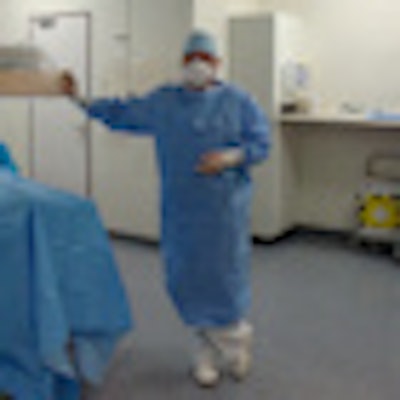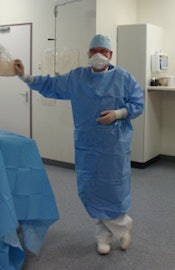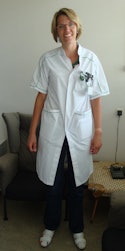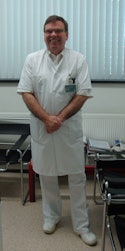
Radiologists across Europe are playing their part in infection control by adhering to ever-stricter regulations on what they can wear at work. The need to prevent the spread of germs, as well as reduce costs, now appears to be more important than comfort and style.
The U.K.'s "bare below the elbows" policy, approved 16 September 2010 (NHSCT/10/349) aimed at fighting the increasing numbers of methicillin-resistant Staphylococcus aureus (MRSA) and Clostridium difficile (C. diff) cases seen between 2009 and 2010 in U.K. hospitals. Although the policy has been in operation for less than a year, its implementation has elicited a large range of responses, from whole-hearted approval, to concern the policy has been issued hastily and is not supported by demonstrable scientific evidence, to opinions that imply the policy is a half-hearted solution to a complex problem.
 Interventional radiologists cover up at the Atrium Medical Center Parkstad in the Netherlands. All images courtesy of Dr. Miraude Adriaensen.
Interventional radiologists cover up at the Atrium Medical Center Parkstad in the Netherlands. All images courtesy of Dr. Miraude Adriaensen.
The policy only applies to doctors seeing or treating patients, for example in clinic or on ward rounds. Doctors not in contact with patients are exempt from the policy, which includes clean and short nails, only plain band rings without stones, no wristwatches or jewelry such as bracelets, and sleeves that are worn short or rolled up. If ties are worn, they must be tucked in or of the bow variety.
Infectious media may survive on surfaces for a long time, but the risk of transmission of infectious agents via clothing worn by healthcare professionals varies depending on the circumstances, according to infection control professionals. Demonstrating this in clinical studies would be possible but cumbersome because so many variables need to be to consider. However professionals agree that "bare below elbows" is a simple and proactive measure that most importantly allows doctors to wash their hands thoroughly.
"Being bare 'below the elbows' makes sense as it facilitates optimal hand hygiene, but if one would like to eliminate the risk of passing on infections through clothing, separate hospital work clothes that can be washed at high temperatures may be more effective. This, however, would mean a considerable investment, which may not be possible at present," said Dr. Christiane Nyhsen, a consultant radiologist at the Sunderland Royal Hospital in the U.K.
If hospitals in the U.K. were to wash all work clothes and uniforms, the National Health Service (NHS) would have to find some way of funding it, and this might involve employees, patients, or taxpayers paying for the service, as in other countries. Some U.K. hospitals offer to wash nurses' uniforms, but this is not obligatory, and many healthcare professionals prefer to wash their own to avoid time delays and ensure uniforms don't get lost.
Nyhsen points to the usefulness of work clothes for patients in terms of staff identification.
"In our hospital, doctors in the accident and emergency area and the intensive care unit already wear identifiable hospital uniforms to be worn at work only, which is excellent from the infection control aspect as well as practical for doctors in their work environment," she said.
Similar dress codes for medical specialists exist in the Netherlands, according to Dr. Miraude Adriaensen, a radiologist at the Atrium Medical Center Parkstad in Heerlen, the Netherlands. Nails have to be short and clean. Hair must be clean, and if it's long, tied up or back. Arms must be bare below the elbow. Importantly, anyone in contact with patients has to wear hospital clothing that must be washed by the hospital, not at home. In addition it must be put on and taken off inside the hospital and never worn outside the hospital. It must also cover personal clothing down to the knees. This laundry service is provided by the hospital.
Adriaensen wears a short-sleeved white coat to the knees. In her hospital, interventional radiologists wear scrubs underneath a long-sleeved aseptic disposable gown that covers them from neck to feet, as well as mask, gloves, and hat. No fake nails, jewelry below the elbow, or jewelry on top of the hospital clothing is allowed in the radiology department, and this is applies for all modalities.
"In the Netherlands, doctors sense that the ethos particularly in the operating room is getting stricter," she noted. "But GPs [general practitioners] have become less formal and often skip the whites unless performing an aseptic procedure."
Adriaensen notices a stark difference between the diversity of Europe and the uniformity of the U.S. -- where she was a Harvard officer and research fellow in radiology (2000-2001), and returned for a rotation/clerkship in pediatric thoracic surgery (2003) -- where all doctors wore scrubs and a white coat. However during her stay it was quite common for doctors to go on breaks outside the hospital still in their white coats, raising the issue of potential contamination of patients.

 Dutch radiologists Dr. J De Vries (left) and Dr. H. Odink (right) wear short-sleeved "whites" that are washed by the hospital and are not allowed to be worn off the premises.
Dutch radiologists Dr. J De Vries (left) and Dr. H. Odink (right) wear short-sleeved "whites" that are washed by the hospital and are not allowed to be worn off the premises.
Dr. Hussain Al-Balushi, an interventional musculoskeletal consultant radiologist at the AFH in Oman, undertook his training in Ireland during 2003 to 2009. Consultants wore suits and interventional doctors wore scrubs during procedures. Diagnostic radiologists wore shirts with ties but there was some partial flexibility in the early days of his training.
"For noninterventional procedures such as upper and lower GIT [gastrointestinal tract] barium studies, doctors would often just wear scrub tops with regular trousers or full scrubs," Al-Balushi said.
As his training progressed and interventional radiology developed, interventional radiology (IR) procedures were conducted in IR suits, which included full scrubs, caps, radiation goggles, and masks.
Al-Balushi's current placement is in Oman where radiologists in general hospitals wear what they like from suits or white coats to Omani clothes, although interventional doctors wear scrubs during procedures.
"My own preference is for comfort and practicality; light clothes with short sleeves and no ties," he said.
He added that female doctors usually respect socio-religious norms and dress modestly. They may wear long sleeves particularly in public places such as hospital corridors and foyers although this is mostly a personal choice.
"My general impression is that hygiene rules of short sleeves for patient contact and procedures are respected," he said.



















